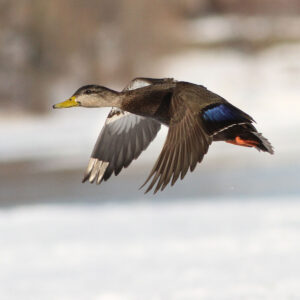Black Duck Conservation Plan

American Black Duck. USFWS
The ACJV Black Duck Working group has finalized the American Black Duck Conservation Plan, which was approved by the Management Board in October. The plan includes state by state habitat objectives needed to meet population goals and details six conservation strategies, identified by the working group, as most critical to achieving these goals. These strategies include:
- Protect Marsh Migration Corridors;
- Develop and Implement BMPs to Facilitate Marsh Migration;
- Restore Tidal Wetland Hydrology;
- Improve Water Level Management on Managed Wetlands;
- Restore and Enhance Non-tidal Wetland Hydrology; and
- Control Exotic and Invasive Species.
These strategies encompass the most important opportunities to improve habitat conditions, slow or reverse habitat loss, and protect high priority wetlands. These strategies also strongly overlap with highest priority strategies for Saltmarsh Sparrow and Black Rail so investments in Black Duck conservation will directly benefit the full range of flagship species needs. The Plan emphasizes the need for partners to make additional and/or more strategic investments in these strategies to increase and maintain future Black Duck populations in the face of growing threats. Together, they represent the most promising approach to maintain and grow the Black Duck population along the Atlantic coast.
Black Duck Decision Support Tool Expansion
John Coluccy, Ducks Unlimited
The American Black Duck Decision Support Tool (DST) has been expanded from the initial focus area in the Mid-Atlantic/New England region to now encompass the entire Black Duck non-breeding range in the Eastern U.S., including the south Atlantic region of the ACJV, southern Eastern Habitat Joint Venture, Appalachian Mountains Joint Venture, Upper Mississippi Great Lakes Joint Venture and Central Hardwoods Joint Venture.
Although the tool represents the energetic needs of all dabbling ducks, it provides specific wetland restoration and protection acre goals to help achieve the NAWMP Black Duck population objective. The DST will help guide black duck conservation efforts by prioritizing restoration and protection actions for the top 20% of watersheds in terms of Black Duck energy needs. Through this tool, land managers will be able to determine the best way to contribute to achieving Black Duck goals across their non-breeding range. The DST is a collaborative effort amongst the Black Duck Joint Venture, Atlantic Coast Joint Venture, Ducks Unlimited, and many other partners.
The final tool is expected sometime this spring.
